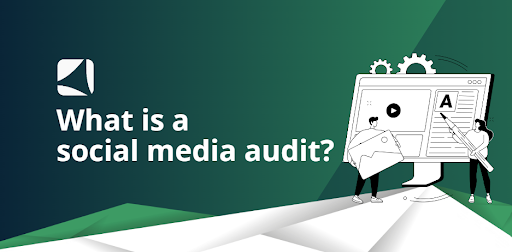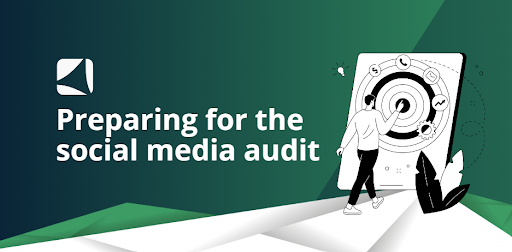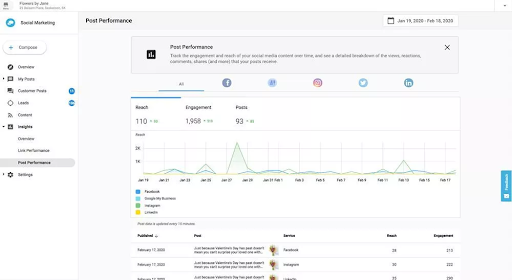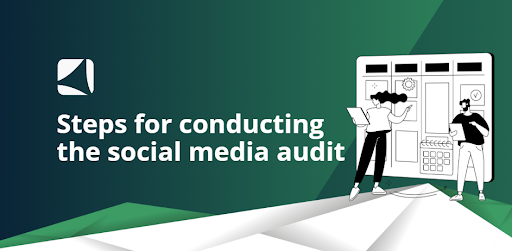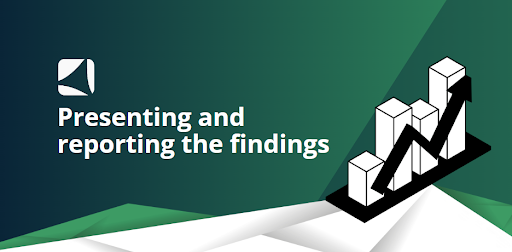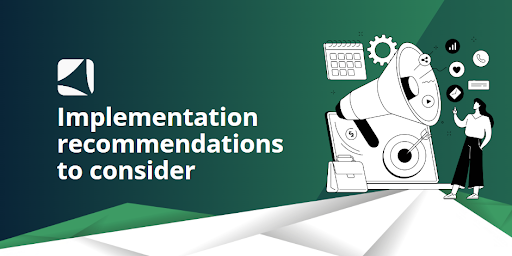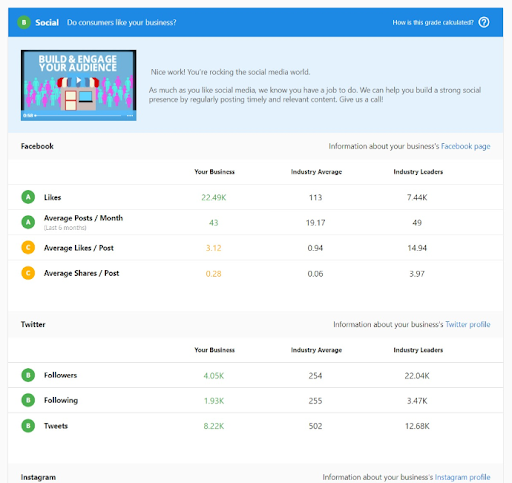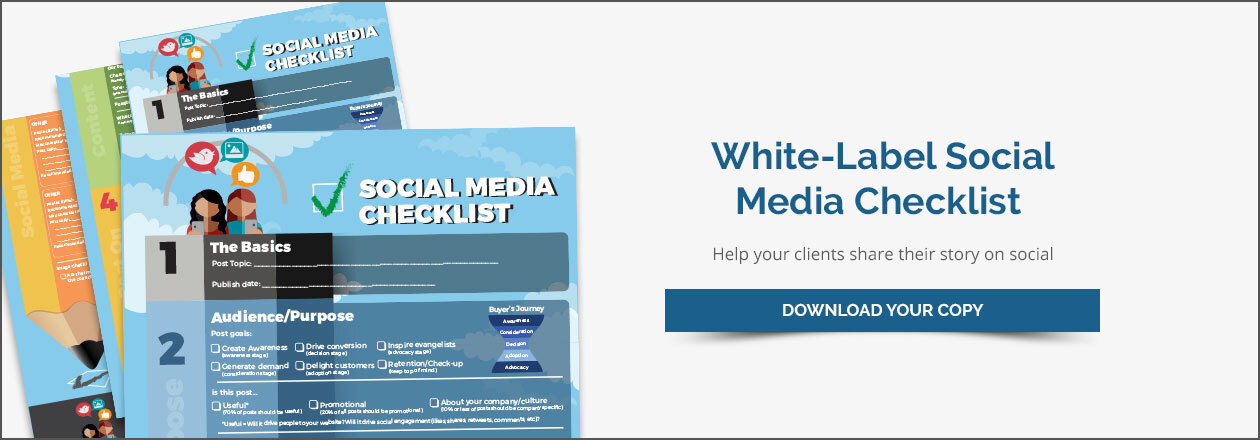Mastering social media audit services: a step-by-step guide for marketing agencies
Wondering if your social media marketing efforts are as effective as they could be? A social media audit helps evaluate and optimize your client’s presence, performance, and goals. Harness it to better identify strengths and weaknesses, and better align your strategies with the client’s objectives. By mastering social media audit services, you can leverage data-driven insights to drive tangible results for your clients.
Be successful with social media on behalf of your clients by downloading “The ultimate guide to effective social media for business” now.
In this comprehensive guide, we will take you through what to expect when preparing a social media marketing audit, how to present your findings, and what to consider before implementing recommendations.
What is a social media audit?
A social media audit comprehensively assesses a business's social media presence. Conducting a social media audit allows marketing agencies to gain valuable insights into the effectiveness of their client’s current social media efforts and make more informed, data-driven decisions to improve them. Here are some key reasons why social media audits are important for any type of marketing agency to perform:
Performance evaluation
A social media audit helps agencies evaluate the performance of their client’s social media campaigns and activities. It provides a clear understanding of what is working and what needs improvement. For example, an agency might find through the audit that their client's Instagram posts receive significantly more engagement than their Facebook counterparts. From here, they can focus their efforts on the platform that delivers better results and adjust their strategy where needed.
Audience analysis
By conducting a social media audit, agencies can gain a deeper understanding of their client’s target audience. They can analyze demographics, interests, and engagement patterns to create more relevant and personalized content. Let's say an agency discovers that their client's primary audience consists of young professionals interested in sustainable living. Armed with this information, the agency can tailor their content to address sustainability topics that resonate with this specific audience, increasing engagement and brand loyalty.
Competitive insights
By assessing your client’s competition strategies, content, and engagement levels, you can identify industry trends, craft performance benchmarks, and discover new opportunities to differentiate your clients from their competitors. For instance, an agency might notice that their client's competitors are using video tutorials to educate their audience. The agency might then suggest incorporating similar educational videos into their client's content strategy to stay competitive.
Content optimization
By identifying top-performing content and analyzing audience engagement, agencies can optimize their client’s content strategy, create more compelling posts, and improve overall engagement. As an example, an agency might find that their client's infographics consistently generate high levels of shares and comments. With this insight in hand, the agency can prioritize creating more infographics and leverage their effectiveness to boost engagement.
Platform evaluation
Analyze engagement metrics and audience behavior on each platform to determine which channels are delivering the best results then focus your social media marketing efforts accordingly. For instance, an agency might discover that their client's Twitter account has a significantly higher click-through rate compared to their LinkedIn. The agency can then work to allocate more resources and prioritize content creation for Twitter, maximizing their client's reach and impact.
Brand consistency
Inconsistency of branding can lead to confusion for users. Audits can ensure that branding elements such as logos, colors, tone of voice, and messaging are aligned, providing a cohesive brand experience for your client’s target audience. During a social media audit, an agency might discover for example that their client has been using an outdated variation of their logo across several social media platforms, causing brand inconsistency. The agency can then provide recommendations on where to make changes to ensure a consistent and recognizable brand identity across all platforms.
Related article: selling social media packages
Preparing for the Social Media Audit (things you'll need)
Here are some essential elements, resources, and information you'll need to prepare for a comprehensive social media audit:
1. Access to social media accounts
Make sure to get login credentials and administrative access to platforms such as Facebook, Twitter, Instagram, LinkedIn, YouTube, and any other relevant channels. Obtaining access allows you to delve into the account settings, review past content, and analyze engagement metrics.
2. Analytics and reporting tools
These tools provide valuable insights into the performance of the client's social media accounts, including reach, impressions, engagement, clicks, and conversions. Popular tools include Facebook Insights, Twitter Analytics, Instagram Insights, LinkedIn Analytics, and third-party tools like Vendasta’s Social Marketing (shown below), Hootsuite, or Google Analytics.
Related topic: guidelines for social media management
3. Brand guidelines
Review the client's brand guidelines thoroughly, taking note of specific colors, image preferences, and writing style. By ensuring content is adhering to the brand guidelines, you can better align your client’s social media strategy with their overall brand identity and maintain a cohesive online presence.
4. Competitive analysis
Research and compile information about their competition’s social media marketing strategies, engagement, content types, and audience demographics. Identify trends in the market, set benchmarks for success, and formulate social media ideas for the businesses you serve.
Steps for conducting the social media audit
To conduct a thorough social media audit, follow these six steps:
Step 1: Analyzing the client's current social media profiles
Review each platform and assess the overall brand presence, profile completeness, and visual aesthetics. Take note of any inconsistencies, outdated information, or irrelevant content that needs improvement.
Step 2: Assessing the client's target demographics
Understand who the client's ideal audience is and determine if their current social media presence aligns with this. Analyze the follower demographics, such as age, gender, location, and interests, as this information will help you to tailor the content strategy to better reach and engage the target audience.
Step 3: Evaluating the current content strategy
Review the types of content being posted, the frequency of posts, and their overall quality. Assess whether the content aligns with the client's brand voice, and identify any gaps or areas where improvements can be made, such as diversifying content formats, incorporating user-generated content, or including more storytelling elements.
Related topic: Quick tips on social media content creation for small businesses
Step 4: Identifying top-performing posts
Analyze the engagement metrics to identify which content resonates the most with your client’s target audience. Look for patterns in terms of topics, formats, or posting times to help replicate this success for future content.
Step 5: Examining engagement metrics
Across all of your client’s platforms evaluate the overall engagement rates. Identify trends and anomalies to understand what is driving engagement and what needs improvement. Look for any audience sentiment indicators, such as positive or negative feedback, and address them accordingly to better manage the business’s online reputation.
Related topic: social media in reputation management
Step 6: Assessing the competitor's social media presence
Scope out and analyze the social media profiles of the client's competitors. Identify their strengths, weaknesses, and unique approaches to capturing engagement to provide valuable insights into what your client is competing against and help identify opportunities for them to differentiate themselves.
Presenting and reporting the findings
Once you have completed the social media audit and analyzed all the data, it's time to report the findings to your client. Present your insights thoroughly and encourage discussion between yourself and the client about the proposed recommendations and action plan.
This way, you can provide your client with a clear understanding of their social media performance and a roadmap for improvement. A collaborative approach will foster trust and set the foundation for a successful partnership moving forward. Here's how to effectively communicate the results of your social media marketing audit:
Organize the data and insights
Before creating the report, organize all the data and insights you've gathered during the audit so you can present the information clearly and logically. Group them into relevant categories, such as platform performance, content analysis, engagement metrics, audience demographics, and competitive analysis.
Create a comprehensive report
Develop a detailed report that summarizes the key findings of the social media audit. Include charts, graphs, and visuals to illustrate the data and make it easier for the client to understand. Start with an executive summary that provides an overview of the audit and its objectives. Then, break down each section of the report, highlighting the most important insights and recommendations.
Present the findings to the client
Schedule a meeting with the client to present the social media audit findings. Start by providing an overview of the process you followed and the scope of the audit you performed. Then, walk them through the report section by section, explaining the data, insights, and recommendations. Use visuals to support your points and ensure clarity. Encourage questions and discussions throughout the presentation to address any concerns or seek further clarification.
Discuss the recommendations and action plan
After presenting the findings, engage in a discussion with the client about the recommendations and the proposed action plan. Explain how the insights from the audit can be translated into actionable steps to improve their social media presence. Then, discuss the strengths and weaknesses identified, as well as potential areas for growth and strategies to address any challenges. Collaborate with the client to prioritize the recommendations and establish realistic goals and timelines for completing them.
During the discussion, be open to the client's input and consider their specific objectives and constraints. Tailor the recommendations to their needs and ensure that the action plan you craft together fully aligns with their overall marketing strategy.
Implementation recommendations to consider
Clear communication between a social media marketing agency and its clients is crucial for effectively implementing your recommended changes. A transparent channel allows for understanding client preferences and tailoring strategies where needed.
Having a close collaboration process ensures timely adjustments and helps you to build strong client-agency relationships. When it comes to implementing the recommendations from a social media audit, there are several things to consider:
Collaborate with the client to implement the action plan
Work closely with the client to ensure a smooth implementation of the recommended changes. Engage in open communication, establish clear expectations, and collaborate on the execution strategy to foster a shared understanding of goals, increase accountability, and improve the chances of successful implementation.
Pro-tip: Break down the plan into smaller, actionable tasks to make the implementation process more manageable. Assign responsibilities, set deadlines, and create a timeline to keep everyone on track.
Monitor and measure the results
Implement tracking mechanisms and use analytics tools to monitor the impact of the implemented changes. Make sure to continuously measure key performance indicators (KPIs) such as engagement rates, reach, conversions, and follower growth to assess the effectiveness of the new strategies and make data-driven decisions based on your findings.
Adjust the strategy as needed
Stay flexible and ready to make adjustments to the strategy based on the results and feedback you received. Social media landscapes are dynamic, and trends change over time. Regularly evaluate the performance and gather feedback from your client’s audience to identify areas for improvement.
Related topic: 14 ways to instantly ask for a review from happy customers
Keep the client informed about the progress and success achieved through implementing your recommendations. Provide regular updates and reports showcasing the positive outcomes resulting from the changes and celebrate wins to maintain client motivation throughout the adjustment process.
Consider maintaining an open line of communication with the client even after the initial implementation of the recommendations. Encourage them to give their own input regarding the strategy's performance and any emerging opportunities or challenges they have encountered. Ongoing collaboration will ensure you both can grow and improve together as a team, fostering the potential for future social media collaborations on other projects down the line.
Streamline the social media audit process
It’s easy to get overwhelmed as you acquire more and more clients. Managing client social media accounts, prospecting, researching, and reporting can quickly reach a bottleneck. This is where technology can become a marketing agency’s best friend.
Tools such as white-label social media management services, coupled with prospecting tools and automatically recurring reporting for current clients, offer marketing agencies a streamlined solution that can save them time and major headache. With white-label client reporting software, agencies can provide detailed, data-driven reports to current clients, showcasing the impact of their social media strategies.
The Vendasta snapshot report, for example, provides a quick and comprehensive overview of a prospect's social media presence, enabling agencies to identify improvement opportunities quickly and efficiently. It helps you to showcase value to prospects, and secure new clients more effectively.
By leveraging these types of prospecting, reporting, and white-label fulfillment tools, agencies can optimize their social media management services while saving time and resources that could be put to use elsewhere.
Frequently asked questions
How much does a social media audit service cost?
Typically, audit services are priced based on an hourly rate or a flat fee. The cost of a social media audit can vary depending on several factors, including the complexity of the audit, the size of the client's social media presence, the level of detail required, and the expertise of the agency or consultant providing the service.
How long does a social media audit service take?
Generally, a social media audit can take anywhere from a few days to a few weeks to complete depending on the scope of the project, how much data you can extract, how long it takes to analyze the information, and the availability and responsiveness of the client. Factor in all these variables when quoting a deadline or price for your services.


